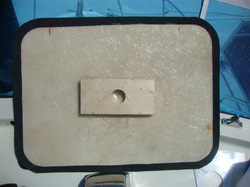Ponding Water on Cover
Here on the wet coast, even in summer, it rains regularly. A previous blog showed how I dealt with ponding water on my winter cover using posts and plastic plates. This is the same approach applied to the summer cover, however here rather than plastic plates I used fiberglass. A panel of fiberglass was fabricated by doing a layup on melamine and then using a jig saw to cut it to shape. The actual piece of fiberglass I used was left over from a previous job, but you can see pictures of the technique used in my blog write up on making a new entry door.
On one side of the fiberglass plate I glued a square of carpet, somewhat larger than the fiberglass. This would prevent the hard edges of the fiberglass from chewing through the canvas cover. On the other side of the fiberglass I glued a block of wood with a hole in it using epoxy. The wooden hold up rod would go into the hole in the wooden block.
Here on the wet coast, even in summer, it rains regularly. A previous blog showed how I dealt with ponding water on my winter cover using posts and plastic plates. This is the same approach applied to the summer cover, however here rather than plastic plates I used fiberglass. A panel of fiberglass was fabricated by doing a layup on melamine and then using a jig saw to cut it to shape. The actual piece of fiberglass I used was left over from a previous job, but you can see pictures of the technique used in my blog write up on making a new entry door.
On one side of the fiberglass plate I glued a square of carpet, somewhat larger than the fiberglass. This would prevent the hard edges of the fiberglass from chewing through the canvas cover. On the other side of the fiberglass I glued a block of wood with a hole in it using epoxy. The wooden hold up rod would go into the hole in the wooden block.
The steering seat on the upper deck lifts off quite easily, and the pedestal it sits on is a hollow tube. Thus I can just remove the seat and store it on the deck, drop a wooden rod into the seat holder, put the fiberglass plate on top of the wooden rod and zip up the cover. The cover now has slope to shed the rain and prevent it from ponding.














 RSS Feed
RSS Feed